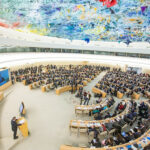Ksapa shares feedback and insights to follow up on our recent webinar with Céline Soubranne Weber (Axa) and Jakob Puchinger (IRT System X, CentraleSupélec). We examine challenges and solutions for stakeholder engagement strategies and outline key trends for the coming years.
It has become fairly customary to consider stakeholder engagement as the cornerstone of corporate responsibility. With seemingly sibylline simplicity, this tool is meant to help companies identify and activate responsibility and innovation strategies, while bolstering their social, societal, environmental and ethical performance. In practice, however, structuring stakeholder dialog is nothing short of complex and all the more so in our currently uncertain and fragmented contexts, particularly in an era of digital transformation and pandemic crisis.
Address Stakeholder Expectations To Secure Economic Performance
Discussing Business Roundtable (BRT) “Statement on the Purpose of a Corporation” was reminiscent of debates that have raged on for decades and most notably Freeman’s stakeholder theories, harking back to 1983. It follows a stakeholder would be defined as an individual or social group likely to positively or negatively influence responsible business conduct. Addressing these stakeholders’ expectation may be spurred by efforts to formalize one’s Purpose Statement. While it may go against the grain from a purely corporate standpoint, it in fact determines a company’s capacity to remain agile and adapt processes, products and/or services.
The Covid-19 crisis violently brought this evidence to bear. Distributing protective gear, donations, redirecting production lines activities, postponing debts, accelerating payments were but some of the numerous measures a company could consider in an attempt to offset their difficulties of their employees, suppliers and communities. A recent Bank of America Merrill Lynch report highlighted a rapid shift among businesses to address their stakeholders’ urgent needs (if not their very survival) rather than pursue short-term financial interests. Indeed, banks alone account for more than $400 billion in interests, which could be deferred, with recovery unlikely to happen in the same accounting year. In other words, on the issue of stakeholder engagement as with so many others, Covid-19 worked as a trend accelerator and amplifier.
Stick To Core Business
Meaningful stakeholder engagement strategies contribute both to the company’s ability to anticipate risks and develop long-term vision. As such, when Axa centers its Purpose statement around the notion of Acting For Human Progress By Protecting What Matters, the underpinning approach is one of active stakeholder listening, for the Group to be able to question and adapt its contribution to the broader society as an insurer. As this pertains to the business of preventing risk, Axa advantageously sticks to its core business by living up to the socio-economic consequences of its decisions. The company likewise embodies its role as an institutional investor by focusing on the long-term performance of its assets under management.
From a corporate viewpoint, developing stakeholder dialog mechanisms does not make inherent sense – particularly with regards to engaging with discordant voices. This approach, however, stands to reinforce the Group’s active listening stance, by demonstrating and exemplifying the coherence and continuity of its strategy. From an operational standpoint, phasing out activities inconsistent with a long-term climate strategy – for instance, coal energy – means closing offices and re-skilling teams, or enforcing all preexisting insurance contracts… in short, managing conflicting injunctions from contrasting stakeholder interests.
Proceed Methodically
To further explore the issue of stakeholder engagement methodology, a recent Ksapa briefing paper offers different perspectives. Dialog is by essence bilateral – or confines to a mere list of grievances. Corporate stakeholder engagement strategies must therefore be structured, which is to say driven by clear goals and mutually understood interests. This methodology ensures the relevance and credibility of the process and generates greater confidence in a company’s ability to fully take into account its stakeholders’ feedback, ideally by embedding it into its proposed solutions.
Continuous dialog is a prerequisite for a company to maintain a consistent trajectory over time, especially in conflictual contexts, which require even further collaboration and with sensitive stakeholders. Faced with the Covid-19 global pandemic, companies that had nurtured the trust of their stakeholders indeed managed comparatively better.
Conversely, a lack of clarity on the mandate, information asymmetry or backtracking on projected results fuels stakeholder frustration, when it does not contribute to the disenfranchisement of already vulnerable populations. This runs the risk of enshrining endemic inequalities but also depriving a company of relevant insights. This could not be truer for businesses that rely on social networks as an engagement tactic: depending on the resources and methodology they use, they can be a formidable feedback loop… or a dangerous agent of disinformation. That said, recent social distancing measures have boosted digital interactions to such an extent one study estimates 92% of surveyed companies coped with Covid-19 by redirecting stakeholder dialog platforms to digital channels and accelerated their broader digital transition in one fell swoop.
Companies must adapt their stakeholder engagement strategy to the goals pursued. Tactics – both in terms of resources and impact – will logically not be the same depending on whether a business hopes to boost its license to operate or promote collective innovation.
For instance, the Anthropolis Chair relies on a partnership between academia, institutions and industry, to reflect on a human-centered sustainable mobility. Its methodology is based on the identification of personas and the development of a narrative apparatus for the society of the future, to assess citizens’ interactions and model uncertainty across different territories. This approach is not limited to data analysis and depends on the diversity of its participants and the multidisciplinary nature of its coordination teams, who strive to seek out users in the field. From the informal economy of public transportation in Morocco to the railway networks developed by public authorities in China, adapting to local realities indeed guarantees the relevance of any instance of dialog. Exploring methodologies, research and applications ultimately helps effectively document and address stakeholder concerns, amid increasingly complex and volatile contexts.
Stay Flexible And Creative
Mapping and prioritizing stakeholders must be carried out rigorously, without sidelining apparently dissonant contributions. Increasingly numerous and specialized social media also provide a useful space for exploration and innovation in identifying relevant – if somewhat contrasting – stakeholders. For example, a major health player involved in developing new patient treatments can no longer ignore dietary evolutions driven by environmental or animal wellbeing concerns. A sustainable mobility company likewise has a vested interest in exploring – by way of personas, for instance – the specificities of different transportation options (cars, bicycles, scooters, buses, pedestrians…) and their cohabitation in any given space (private versus professional needs, generational particularities…).
Conclusion
Societal issues ranging from climate change, the future of work and value sharing have become critical. As such, dialog and the study of innovative solutions are both stepping stones for meaningful stakeholder engagement and help key players secure positions are aligned within broad ecosystems. It is with method and strategic clarity, but also agility and creativity, that companies must design and manage their stakeholder engagement systems in increasingly fragmented, volatile and even conflictual environments.
***
A mission-native company, Ksapa is developing a global reference platform, to mainstream sustainability and inclusion solutions among companies and investors. Some forty organizations joined our conversation on a subject as sensitive and complex as stakeholder engagement, that included PAI Partners Venture Capital and Private Equity, Total, L’Oréal, EDF, BNP Paribas, Schneider Electric, Le Figaro, Challenges, Sanofi, Foncia, STEF, l’Union Sociale pour l’Habitat, l’Institut de Prospective et Sécurité en Europe, Givaudan, Engie, Danone, l’Agence Française de Développement, l’Imperial College of London, Emerging AG, Société Générale CIB, Eramet, TMH International and Editis (Vivendi).
Likewise, feel free to reach out to the Ksapa team and share your questions or solutions!
As a sustainability and corporate responsibility consultant, Margaux joined Ksapa with international experience in public, private and non-profit organizations. She had previously worked for the Deloitte and Quantis sustainability consultancies, lobbied for environmental research on behalf of the INRA and contributed to Total’s extra-financial reporting.
A Franco-American citizen, Margaux holds sustainability certifications from the IEMA and Centrale-Supélec on top of a Masters degree in History, Communications, Business and Internal Affairs.
She is fluent in French, English and Spanish.












